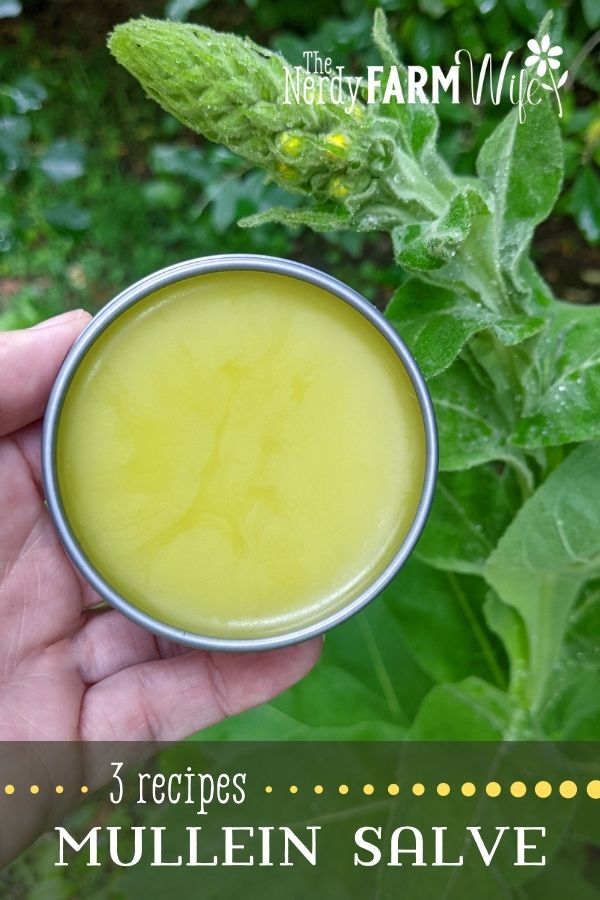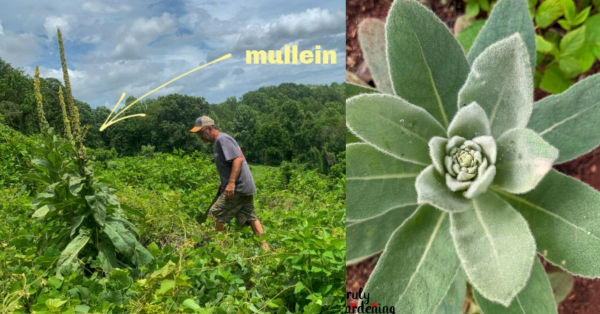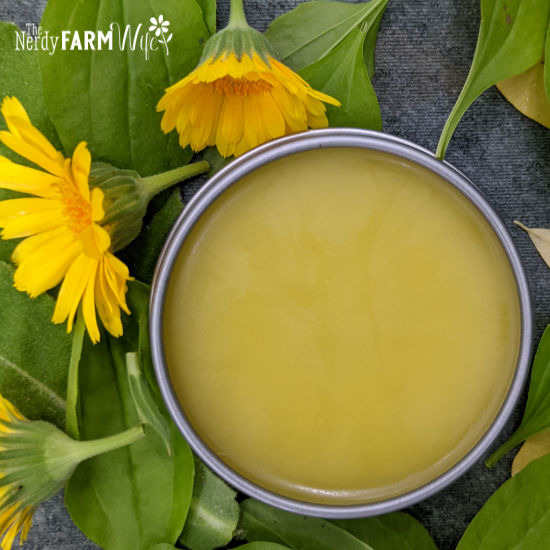How to Make Mullein Salve (3 recipes)
In this article, you’ll learn how to make three herbal salves featuring mullein infused oil:
- Basic Mullein Salve – for dry, chapped, or cracked skin
- Mullein First Aid Salve – for minor scrapes, scratches
- Mullein Chest Rub – for respiratory support

Common mullein (Verbascum thapsus) is an herbal weed you’ve likely seen growing on roadsides and fields.
In its second year of growth, mullein puts out a really tall flower spike that’s hard to miss!
All parts of the mullein plant are useful to humans – except the seeds, but the birds enjoy those.
In this article we’re going to focus on using the flower, since it’s preferred by many herbalists for oil infusions.
The leaf is more commonly used to make tea that’s good for respiratory issues like dry cough or bronchitis, but if that’s all you have available for salve-making, you can use that instead.
Preferably though, instead of the leaf, you can buy organic Mullein Flowers or a ready-made Mullein Infused Oil at Mountain Rose Herbs.

First – if you’re not sure what mullein is, you can learn all about how to forage (or grow) mullein in this article I wrote for Unruly Gardening:
Growing or Foraging for Mullein (+harvesting & preserving tips)
Once you have some mullein in hand, it’s time to make salve!
A salve is a mix of helpful herbal infused oil(s) combined with a wax (most commonly beeswax) to create a beneficial product that’s easy to spread on your skin.
So to make a salve, we first have to make an infused oil.
Some links on this site are affiliate links; I only recommend products I personally use and enjoy. As an Amazon Associate, I earn from qualifying purchases.

Step 1: Make Mullein Infused Oil for Salve
To make infused oil, you’ll need:
- freshly dried mullein flowers
- the oil of your choice – apricot kernel, sweet almond, or sunflower are good choices
There are a few ways to infuse oil, we’ll cover a quick way, a medium way, and a slower way.
The Quick Infusing Method
This method works best if you don’t have the time or desire to wait a few weeks for infused oil.
- Fill a glass canning jar 1/4 to 1/2 of the way with crumbled up dried mullein flowers (or leaves, if flowers aren’t available.) You can also mix in other dried herbs such as calendula, yarrow, etc – see the salve recipes below for ideas.
- Fill the jar almost to the top with your chosen oil – sunflower oil can be good for most skin types. For a slightly lighter feel, try apricot kernel or rice bran oil. You can also mix and match your favorite oils.
- Set the uncovered jar down into a saucepan containing a few inches of water, forming a makeshift double boiler of sorts.
- Place the pan over a low burner and heat for around 2 to 3 hours.
- Don’t allow the water to evaporate out of the pan, and monitor the oil while it’s heating.
- Remove from the heat and strain* out enough oil for your recipe when needed. You can top off the jar with more oil and allow it to continue infusing the slow way until needed again.
- Store the remaining infused oil in a dark spot or cabinet out of direct sunlight and heat. Shelf life should be about 1+ year.
* Be sure to strain mullein oil really well – through a coffee filter or square of old clean t-shirt, to catch the hairs on the plant that may irritate your skin.
The Medium Sunny Window Infusing Method
- Repeat steps 1 and 2 from above, and fill a jar with crumbled herbs and fill with oil. Put a lid on the jar.
- Place the jar in a warm sunny window for a week or two, then transfer to a darker spot to infuse another week or so. The heat from the warm sunny window helps gently speed up the infusing process a bit.
The Slower Traditional Infusing Method
- This way requires more patience and time, but results in a strongly infused and lovely oil.
- Repeat steps 1 and 2 above, and fill a jar with crumbled dried herbs and oil.
- Instead of infusing over heat, you’ll put a lid on the jar and tuck it away in a cabinet or on a shelf and let it infuse for at least 4 to 6 weeks, shaking occasionally as you remember to.
- Strain out the oil needed for your recipe.

Step 2: Make the Salve
First, we’ll cover how to make a basic mullein salve that requires just infused oil and beeswax. Then, I’ll show you how to tinker with the basic recipe to create different kinds of salve, such as a first aid salve and a chest rub.
Basic Mullein Salve
This is an all-purpose no-frills mullein salve. It’s helpful for dry, cracked, chapped skin and could be used on minor scrapes and scratches similar to the first aid salve below. You can even use it as a lip balm for chapped lips.
Ingredients for Basic Mullein Salve:
- 1.6 oz (45 g) mullein flower infused oil
- 0.25 oz (7 g) beeswax
Directions to Make the Salves:
- Combine the infused oil and beeswax in a small heatproof jar or container.
- Place the jar into a saucepan with a few inches of water, forming a double boiler.
- Heat over medium-low heat until completely melted.
- Remove from heat and pour into a 2-ounce tin or glass jar.
- If the recipe calls for essential oils, add after removing from heat.
- Let cool before putting the top on the container.
- Store in a cool dry place. Shelf life is at least 1 year.
Mullein First Aid Salve
Basic mullein salve alone is really nice, but to amp it up into a stronger first aid salve, consider adding the following herbs to the infusion:
Calendula (Calenduala officinalis) – which has antiseptic, anti-itching, and anti-inflammatory properties.
Plantain (Plantago major) – which is a common leafy weed that cools and soothes, and is one of the best herbs for skin irritations, cuts, bug bites, and scrapes.
We’ll also add a couple of drops of lavender and tea tree essential oil to boost the healing power.
Ingredients for Mullein First Aid Salve:
- 1.6 oz (45 g) oil infused with mullein, calendula, plantain
- 0.25 oz (7 g) beeswax
- 1 drop tea tree essential oil + 3 drops lavender essential oil
Mullein & Eucalyptus Chest Rub
Mullein has an affinity for the lungs and is often used internally and externally to help dry unproductive coughs and bronchitis. In this salve variation, we’re going to add in essential oils that are helpful to use in vapor or chest rubs.
It’s created for older teens and adults. For younger kids, try replacing the essential oils with something gentler, such as KidSafe Sniffle Stopper by Plant Therapy.
Ingredients for Mullein & Eucalyptus Chest Rub
- 1.6 oz (45 g) oil infused with mullein
- 0.25 oz (7 g) beeswax
- 30 drops eucalyptus essential oil
- 10 drops peppermint essential oil
- 2 drops white camphor essential oil
- optional: 2 drops manuka essential oil
References & Sources
Cech, Richo. Making Plant Medicine.
Foret, Rosalee de la; Han, Emily. Wild Remedies.
Wood, Matthew. The Earthwise Herbal, a Complete Guide to Old World Medicinal Plants.


Hi there! Love your 101 Easy Homemade Products book.
You may want to have a look at this video from An American Homestead.
https://www.youtube.com/watch?v=SmjZ5TnZMXY
It’s rather interesting at the very least and food for thought on the use of crushed seeds in a salve, maybe?
Hi Toni! Thanks for sharing! I remember reading that about the seeds stunning fish – very interesting quirk of the plant for sure! (But yes, definitely illegal & not recommended.) :)
Hi Jan I’m new at this I’m looking for recipes for mullin making . I be found a few recipes that seem’s to be what I’m looking for. I’m not sure on how to process mullin for tea’s . And if you pick the flowers off will it steal seed and replace new plants.
Hi Velera! To process for tea, all you have to do is dry the leaves.
Here’s a section on that in an article about mullein that I wrote at my other website (Unruly Gardening):
https://unrulygardening.com/growing-foraging-mullein/#how-to-dry–preserve-mullein
One they’re dry, you can crumble the leaves up, pour simmering hot water over them, and steep about 10 to 15 minutes (or to taste) to make tea.
However, since mullein leaves have very fine hairs on them, make sure you strain that tea through something that catches the fine hairs, like a coffee filter or several layers of cheesecloth.
Any flowers you pick won’t turn into seed. However, mullein makes a lot of seed and new plants pop up every year in unexpected places. As long as you leave a few of the flowers on the plant, it should be enough to keep producing new plants. :)
these sound great thank you
Hi Kathy! I’m glad to hear you like the recipes! ?
Jen! First off I am obsessed with everything you share and love all.your recipes!
Second…as I am new to making my own stuff I don’t have a ton of essential oils on hand…actually I have like 1 or 2 lol
With being said can I still make the chest rub without the Manuka and camphor?
Hi Jessie, Thanks for the kind words! So happy you like the recipes! :)
Yes, you could definitely leave out the manuka.
The camphor helps give the rub some extra oomph (it’s very potent!), but eucalyptus and peppermint alone are great too.
What you could do is make the chest rub with the eucalyptus and peppermint, and add an extra 2 or 3 drops each of the eucalyptus & peppermint oils to help make up for no camphor or manuka. :)
Hi I love your article.. Quick question for you. Instead of using the essential oils, could you just make an Oil infusion with all these herbs & use that oil for the salve? (I do cold infusion and let it infuse for at least 4 mo, the longer the better) That way you still get the benefits of them all, and if you don’t have the Essential oils it would be ok??
Hi Crystal, Yes! That sounds like a wonderful idea to experiment with.
Sometimes, as in the cases of stuffy noses, it’s hard to beat the aromatic power of essential oils, but I personally favor using salves, lotions, and soaps with just the plant-infused oils in them in more cases than not.
Was wondering about using eucalyptus flakes, I do not have camphor or manuka oils. Thanks. Also want to add that I love your recipes for mullein and look forward to other medicinal recipes.
Hi Sandy, So happy to hear you enjoy the mullein recipes! I haven’t used eucalyptus flakes in salve before – they sound interesting!
I have used menthol crystals though & they work well in salves. If eucalyptus flakes work in a similar way and can be added to cosmetics, then I’d give it a try.
The vendor you purchase them from should have information on max usage rates for the flakes.
Hi! Was wondering how much of the Sniffle Stopper to use for smaller children?
Hi Tammy! The Sniffle Stopper directions say to dilute for topical use at 3 to 5%, and they recommend for ages 2 to 10.
The Mullein & Eucalyptus Chest Rub recipe has a dilution rate of almost 4%.
(Here’s my EO dilution chart for reference:) https://thenerdyfarmwife.com/eo-dilution-chart-skincare/
So I think you could use the same amount of essential oils – 44 total drops – and still be within their suggested safe range. :)
Can you infuse just the leaves or is it better to use the flower?
Hi Tammy! The flowers are great to use when possible, but if you only have leaves, they can be used too.
Or you can mix flowers and leaves together.
If using mullein leaves, just be sure to strain the oil really well, since the leaves have those tiny hairs on them that can irritate sensitive skin.
Jan I love your recipes and guidance. I am growing Indigo – Persicaria tinctoria – and took some fresh leaves and filled jar then with warmed coconut oil and put in cabinet for a month. It is now a beautiful blue. I was told to let it cure for 6mo and then make a salve. Any recommendations? I was told the indigo is healing and soothing.
Hi Michele, Your oil sounds wonderful!
My only experience with indigo is using it as a soap colorant; I haven’t tried it as a salve.
I wonder if it would stain your skin?
I would love to hear how it works out as a salve, if you get to give it a try! :)
Thank you for these recipes! I have been using some of your recipes for our herb class I teach for my homeschool co-op and the kids really enjoy making their own herbal creations! I send the parents info from your site. God bless
Can I use this for chapped lips? Also, is castor oil not an okay oil for infusing herbs? I am very new to this but have been into holistic health for over 20 years. Just new to the infusing herbs and making soap. I am excited to learn though and am SO happy I found your site <3
Hi Lyndsey! I’m so happy you’re enjoying the site! :)
Yes, the basic mullein salve would work great for chapped lips.
Castor oil is fine to infuse herbs in, but because of its thicker consistency, I like to mix it with one or more other oils.
For example, I have a CBD & herb infused oil blend (that later turns into a salve) that has maybe 10% castor oil, and the rest is a combination of sunflower, fractionated coconut oil, jojoba, tamanu oil, and/or other oils that I happen to have on hand.
I am interested in the quick infusion. I have a Levo and was wondering what temp to set it to? With the Levo I can set temp and how long to infuse. I know some herbs lose their potency if heated too high.
Hi Kelly, That’s so awesome to have a Levo infusion machine! I have to confess that I don’t usually check the temperature of my infusions, so am not positive about a specific number.
I do try to keep it very gentle and low, so if your Levo has a range of temperatures to choose from, I would definitely pick towards the lower end of it.